Liveaboard: Diving Tubbataha Atoll Aboard the Philippine Siren
Welcome to Tubbataha
The sea is as slick and clear as glass, the air is thick with heat, and nothing remains except to roll of the tenders for the first time to see whether reality can match expectation. We are immediately pulled on a brisk current, soaring over the reef like birds of prey, except we’re searching for photo opportunities. We drop over the edge of the steep reef, and an explosion of longfin bannerfish surrounds us like confetti, while fusiliers parade in swarms as far as the eye can see.
We are diving at Shark Airport, one of Tubbataha’s signature dives. Whitetip sharks are abundant, sleeping in the coral rubble and patrolling the steep slope. Juvenile reef sharks are active among the schooling snapper and redtooth triggerfish that swim against the current. The deeper reef is punctuated by large colorful fans and sea whips, and is home to plenty of photo-worthy denizens: hawkfish, angelfish, dottybacks, fire gobies, clown triggers and an endless variety of cleaner wrasses. The shallow reeftop is equally spectacular and provides a perfect end-of-dive profile with massive groupings of damsels and jewel-like anthias pulsing in and around the coral heads like butterflies in a flower garden. For a few, a dive here is made epic when a majestic whale shark makes a brief passage through the protected waters of the North Atoll.
Traveling to far-flung dive destinations has a special appeal. Yes, the travel to reach these destinations might be a bit taxing for North American divers, but when you touch down in a tiny airport servicing an outpost like Puerto Princesa on the Island of Palawan, you know you’re in for a very special experience.
This little harbor town on the far western edge of the Philippines is our departure point for a journey to one of the Indo-Pacific’s most famous reefs: Tubbataha Atoll. Despite its fame, logistics mean that we are among the lucky few who visit each year. As we count our mountain of luggage in the blazing tropical sunshine, all thoughts of travel hardship are forgotten as we focus solely on the adventure ahead. This is all the more true as we first view our floating home for the week, sitting at anchor in the harbor. The Philippine Siren liveaboard is crafted in the traditional Phinisi style from solid wood. “I feel like a pirate in search of treasure,” says guest Jenny Stock as she boards the Siren.
Tubbataha Reefs Natural Park is comprised of two huge atolls and one seamount in the middle of the Sulu Sea. It takes roughly 12 hours of open-ocean cruising to reach it — and that’s in good weather. The heavy, solid nature of the yacht makes for a welcome soft passage. Being this remote, the region is accessible only by liveaboard yachts during a short, three-month-long weather window each year.
The park was established in 1988, making it one of the oldest marine parks in Asia, and this long- standing protection promises prolific marine life and exceptional reefs. Researchers have discovered that this submarine eden is a nursery for a huge portion of the Coral Triangle, including Indonesia, Malaysia and, of course, the Philippines. There are few places on Earth that serve up such density of life, and our anticipation after the overnight cruise is electric.
**Next Page: Tubbataha's Colorful Creatures
**
Tubbataha is famous for its schooling fish, which show up almost everywhere — and we are not disappointed. We work counterclockwise around the massive atolls, dropping down on a plethora of sites. Some dives have a little bit of everything, and others deliver particular experiences in spades. Schools of bigeye jacks number in the hundreds on several sites, but on a site called the Delsen Wreck, they envelop lucky divers — shifting, turning and charging as one.
After being wowed by the giant school, we turn our focus to smaller, more-colorful schools, such as the diagonal-banded and many-spotted sweetlips that pile up at cleaning stations on the reef top. Mouths open and gills spread for the small wrasse that provide services at these marine spas, the blissed-out clientele are often a more cooperative photo subject.
Dive times always expire before we exhaust our photo ops, but returning to our elegant vessel is a definite pleasure. Cold drinks and hot tea are proffered by our friendly steward before we even peel out of our wetsuits, and one of the crew whisks it away for a soapy bath (wetsuits appear atop our tanks in time for the next dive). We are spoiled. Four dives a day is the norm, and with five eat ing sessions planned, there is barely time to sneak in a nap or a delicious massage in the afternoon. (Yes, one can always pass on a dive, but in a place like Tubbataha, not many will opt for this.) As guest Richard Rostant says after surfacing from his first whale-shark encounter ever at the site named Ko Ok, “Anything can happen here, on any dive — every moment counts!”
The one thing that no one ever misses is dinner, when the chef reveals the evening’s many-course menu in elaborate and charming detail. Finally, after describing every last condiment, he issues an invitation: “Feel at home — what are you waiting for?” To which we respond with cheers, clinking silverware, mild mayhem and hearty appetites.
Our amazing weather conditions each morning — placid seas, no wind — defies description. There’s no land in sight, save spits of sand and one chunk of limestone with a lighthouse on the South Atoll, and so finding where water meets sky is nearly futile. Our underwater exploits are accompanied by a riot of color and frenetic activity. Dives on Donato’s Wall — named for our incredible dive guide, whose wit and contagious laughter are legendary — serve up caves and overhangs draped with soft corals and sponges, lined with plush tubastrea coral. Some of our favorite photo subjects are the tight schools of pennant bannerfsh that form stacks beneath the brilliant sea fans — as these fish wait to be cleaned, we are treated to a carnival of color. Big dogtooth tuna and giant trevally jacks prowl on the reef edge, and hawksbill and green sea turtles soar overhead going to and from the reef top. These marine reptiles are seen on virtually every dive, and largely ignore us as they feed and visit cleaning stations. On some sites they appear all over the reef — particularly at dusk, when they might be finding refuge from predators like the local tiger sharks.
On our last day we head for Jessie Beazley Reef, a seamount with a substantial plateau rising from the depths — this outpost is a magnet for pelagics from miles around. The Siren is one of only a handful of boats to visit this distant corner of the park, which is hours from the other atolls. It’s wild even by Tubbataha standards, and delivers unexpected wonders on every visit. Working with the current is key, and when we find the spot where the action is happening on our last dive, we can only sit back and watch the show. It’s as if we’ve crashed the most festive party on the reef. Schools of batfish, jacks, bannerfish, triggers and snapper mingle at random, while butterflyfish and anthias rain down like leaves on a fall day. Hundreds of fish tighten as the current strengthens, parting only for the reef sharks that cut a swath through the schools of fish. It is a scene that casts a spell that can be broken only by our computers’ deco limits.
This is why we make the long journey, why we come back again and again. We board a boat in search of sea treasure — Tubbataha delivers it in abundance.
**Next Page: What to Know Before You Go
**
NEED TO KNOW
When to Go: Philippine Siren (sirenfleet.com) spends the year broken into five itineraries based on diving conditions. For Tubbataha, the season is mid-March to mid-June.
Dive Conditions: Diving the Philippines can be very different depending on location. In most, visibility ranges from 50 to 100 feet, and temperatures from 79 to 82 degrees F. Strong currents and cold upwellings can be present in many locations. The Philippines is located in a typhoon belt, so trip insurance is highly recommended for diving any time of year.
Operator: There are eight deluxe cabins — all with private bathrooms — for up to 16 passengers. The Philippine Siren provides three dive guides for its guests, plus an onboard staff of nine. Two tenders handle the divers in three boat runs to the sites.
Price Tag: A six-night charter to Tubbataha with up to four dives per day runs roughly $3,700 per person.
5 REASONS TO DIVE TUBBATAHA ABOARD _PHILIPPINE SIREN _
1. Spacious****** **and****** **comfortable****** **cabins Twin or double cabins come with plenty of room, soft cotton robes, fresh towels, and an in-room computer loaded with movies — as if you’ll have time to watch them.
2. Facilities for underwater photographers and videographers The Siren provides both indoor and outdoor areas desig- nated for charging, means to prepare your camera and video equipment, large rinse tanks on the dive deck, and a well-trained crew.
3. Excellent service Whether it’s ordering a cappuccino, getting a massage on the aft deck, or making sure your laundry is clean, the crew is ready to help.
4. Better than home-style cooking Sumptuous vittles always abound — so much so, you might wish for a larger wetsuit by the end.
5. Free soft drinks, beer and nitrox When you’ve spent a few bucks to get there, it’s nice to have a few perks!
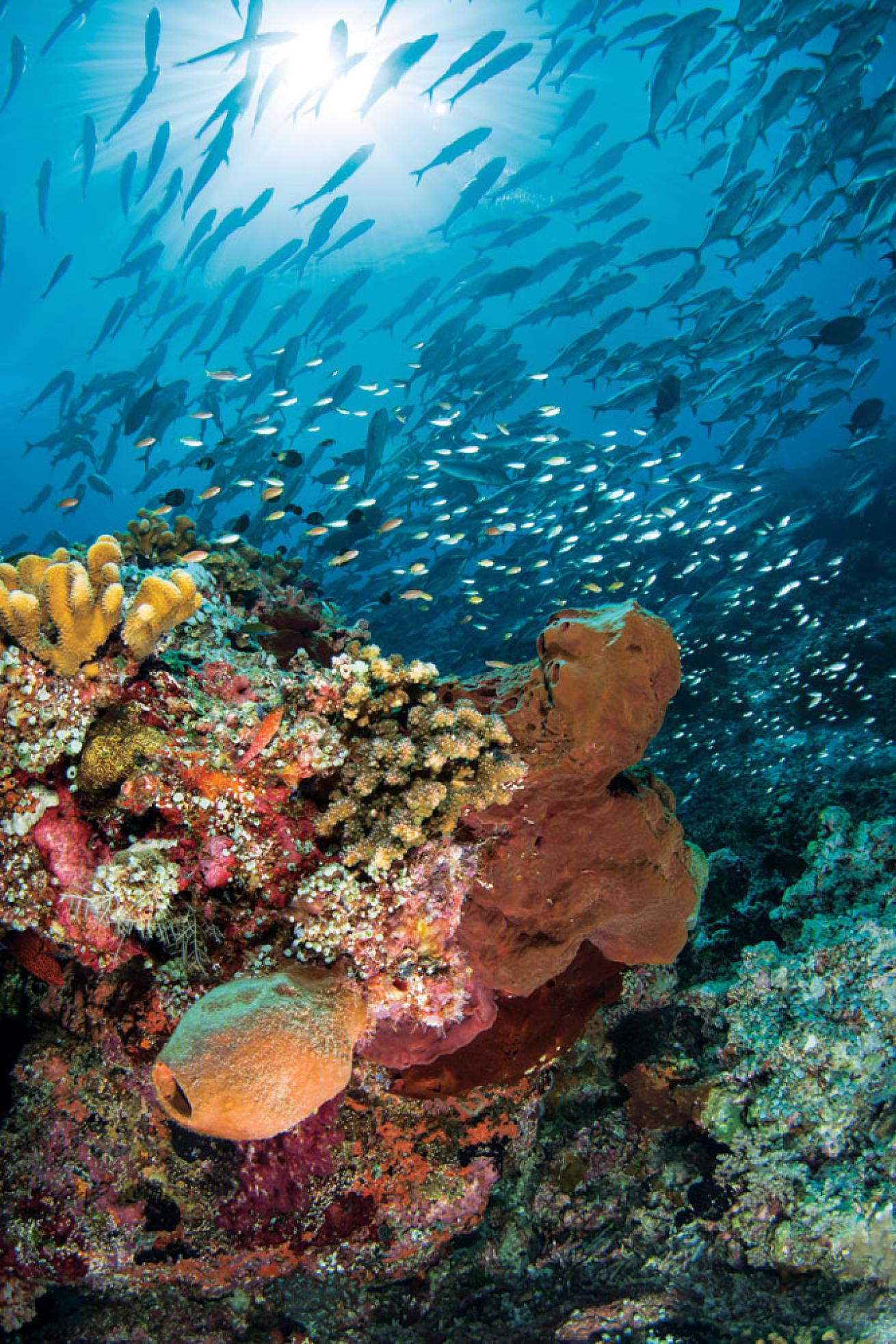
Kevin Palmer and Tanya BurnettA school of bigeye jacks moves into the current in Tubbataha Atoll.
Welcome to Tubbataha
The sea is as slick and clear as glass, the air is thick with heat, and nothing remains except to roll of the tenders for the first time to see whether reality can match expectation. We are immediately pulled on a brisk current, soaring over the reef like birds of prey, except we’re searching for photo opportunities. We drop over the edge of the steep reef, and an explosion of longfin bannerfish surrounds us like confetti, while fusiliers parade in swarms as far as the eye can see.
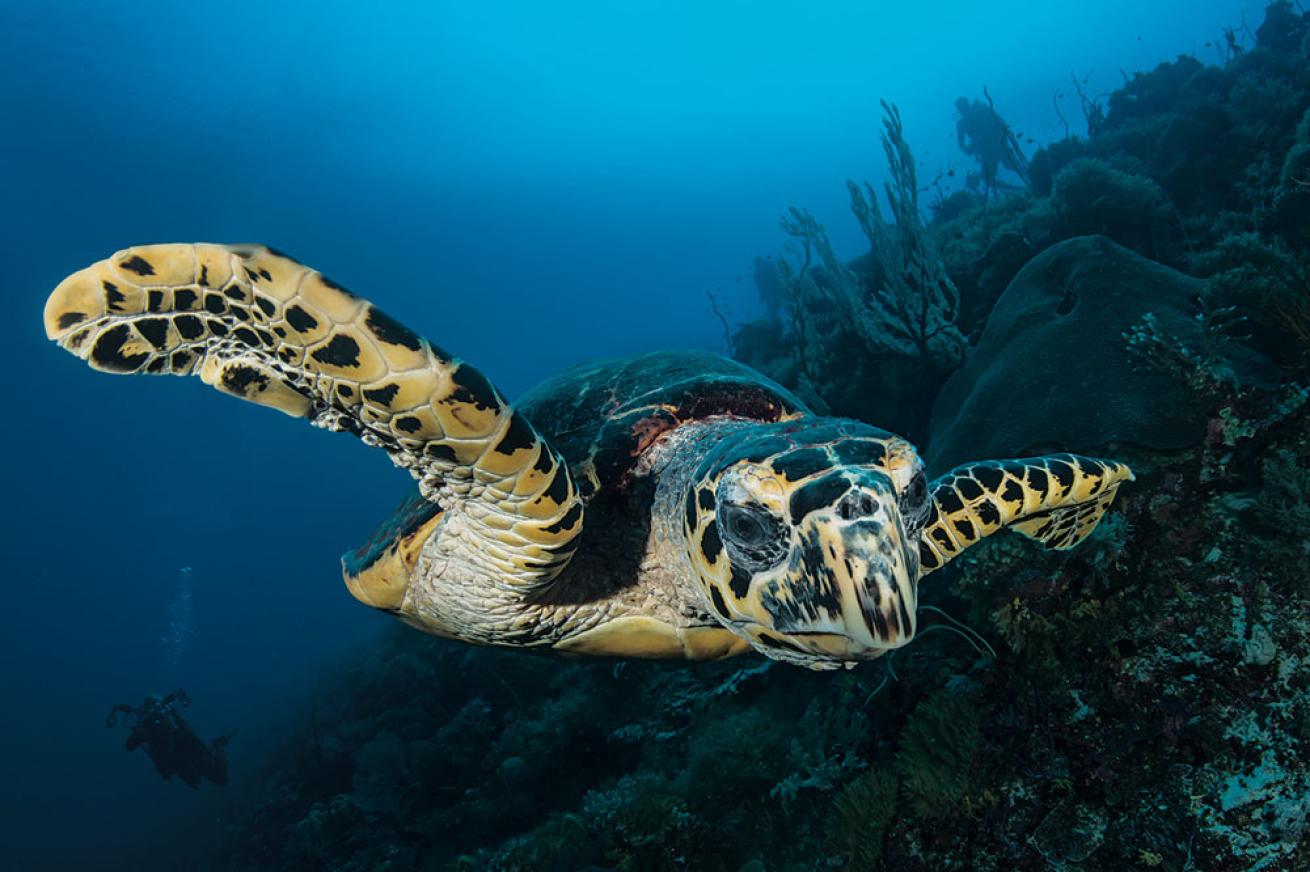
Kevin Palmer and Tanya BurnettA hawksbill sea turtle off Ko Ok, Philippines.
We are diving at Shark Airport, one of Tubbataha’s signature dives. Whitetip sharks are abundant, sleeping in the coral rubble and patrolling the steep slope. Juvenile reef sharks are active among the schooling snapper and redtooth triggerfish that swim against the current. The deeper reef is punctuated by large colorful fans and sea whips, and is home to plenty of photo-worthy denizens: hawkfish, angelfish, dottybacks, fire gobies, clown triggers and an endless variety of cleaner wrasses. The shallow reeftop is equally spectacular and provides a perfect end-of-dive profile with massive groupings of damsels and jewel-like anthias pulsing in and around the coral heads like butterflies in a flower garden. For a few, a dive here is made epic when a majestic whale shark makes a brief passage through the protected waters of the North Atoll.
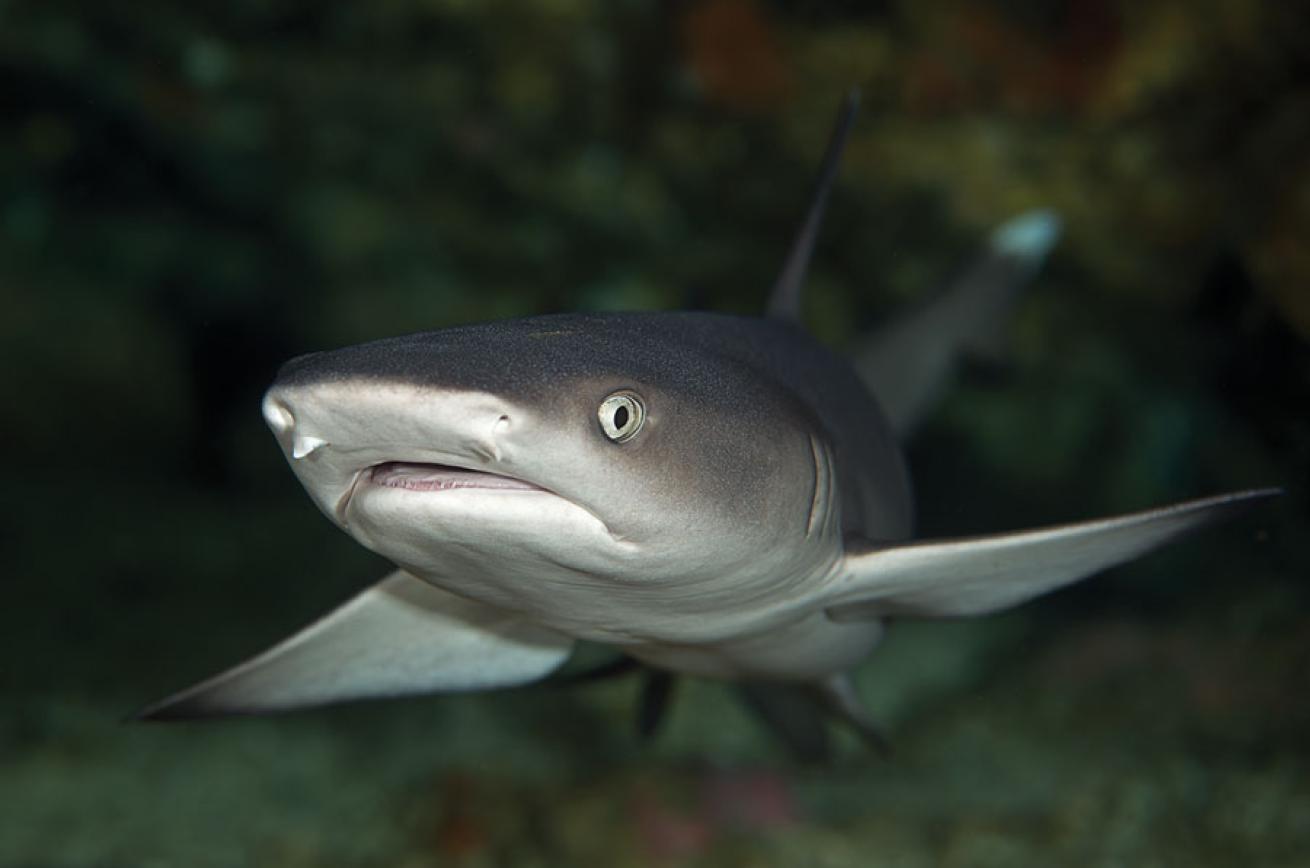
Kevin Palmer and Tanya BurnettWhitetip reef sharks are often spotted when diving in Tubbataha. Shark Airport is one of Tubbataha's signature dives.
Traveling to far-flung dive destinations has a special appeal. Yes, the travel to reach these destinations might be a bit taxing for North American divers, but when you touch down in a tiny airport servicing an outpost like Puerto Princesa on the Island of Palawan, you know you’re in for a very special experience.
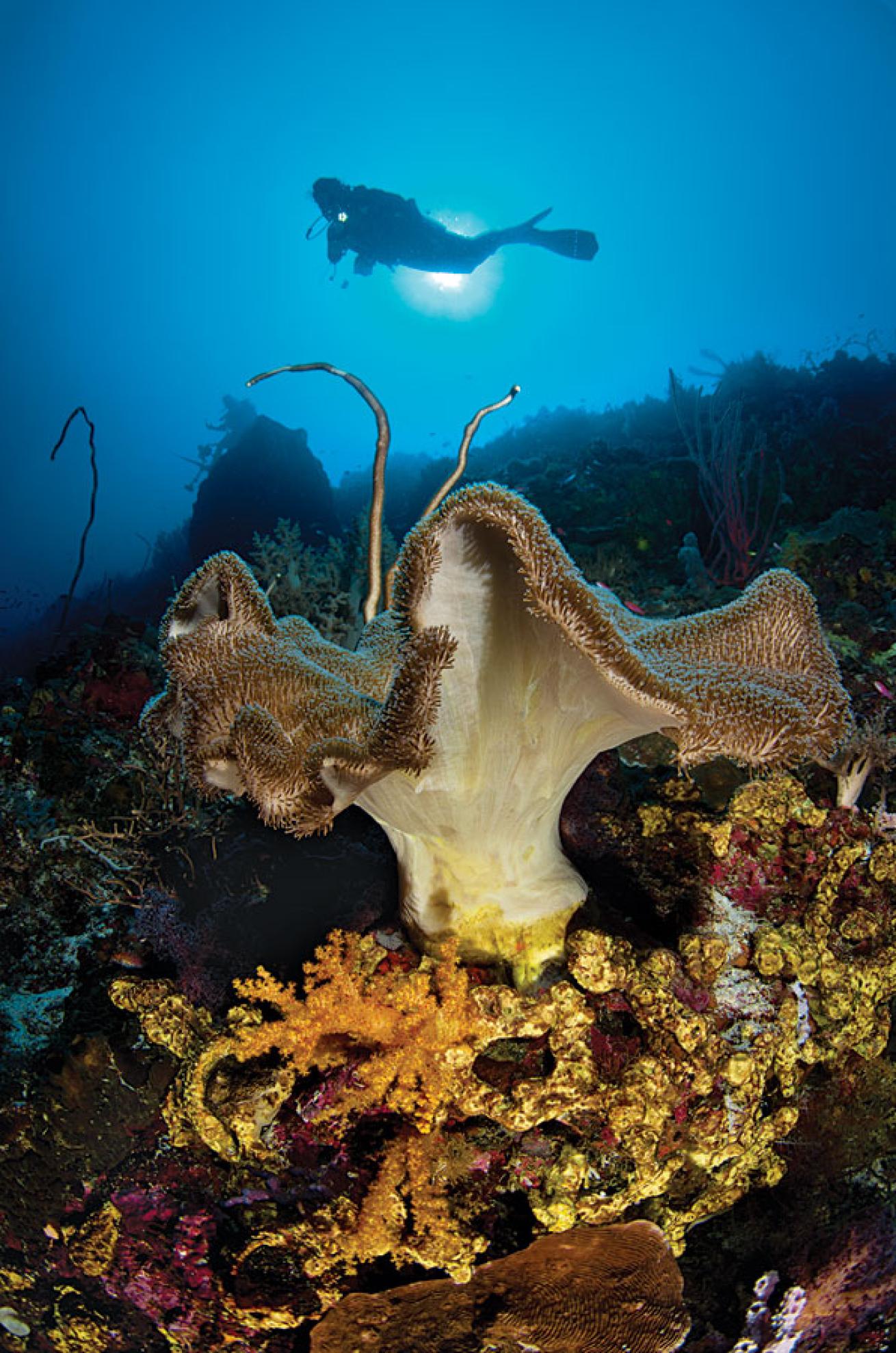
Kevin Palmer and Tanya BurnettGorgeous reef slopes and shallow reeftops make for spectacular profiles when diving Tubbataha Atoll.
This little harbor town on the far western edge of the Philippines is our departure point for a journey to one of the Indo-Pacific’s most famous reefs: Tubbataha Atoll. Despite its fame, logistics mean that we are among the lucky few who visit each year. As we count our mountain of luggage in the blazing tropical sunshine, all thoughts of travel hardship are forgotten as we focus solely on the adventure ahead. This is all the more true as we first view our floating home for the week, sitting at anchor in the harbor. The Philippine Siren liveaboard is crafted in the traditional Phinisi style from solid wood. “I feel like a pirate in search of treasure,” says guest Jenny Stock as she boards the Siren.
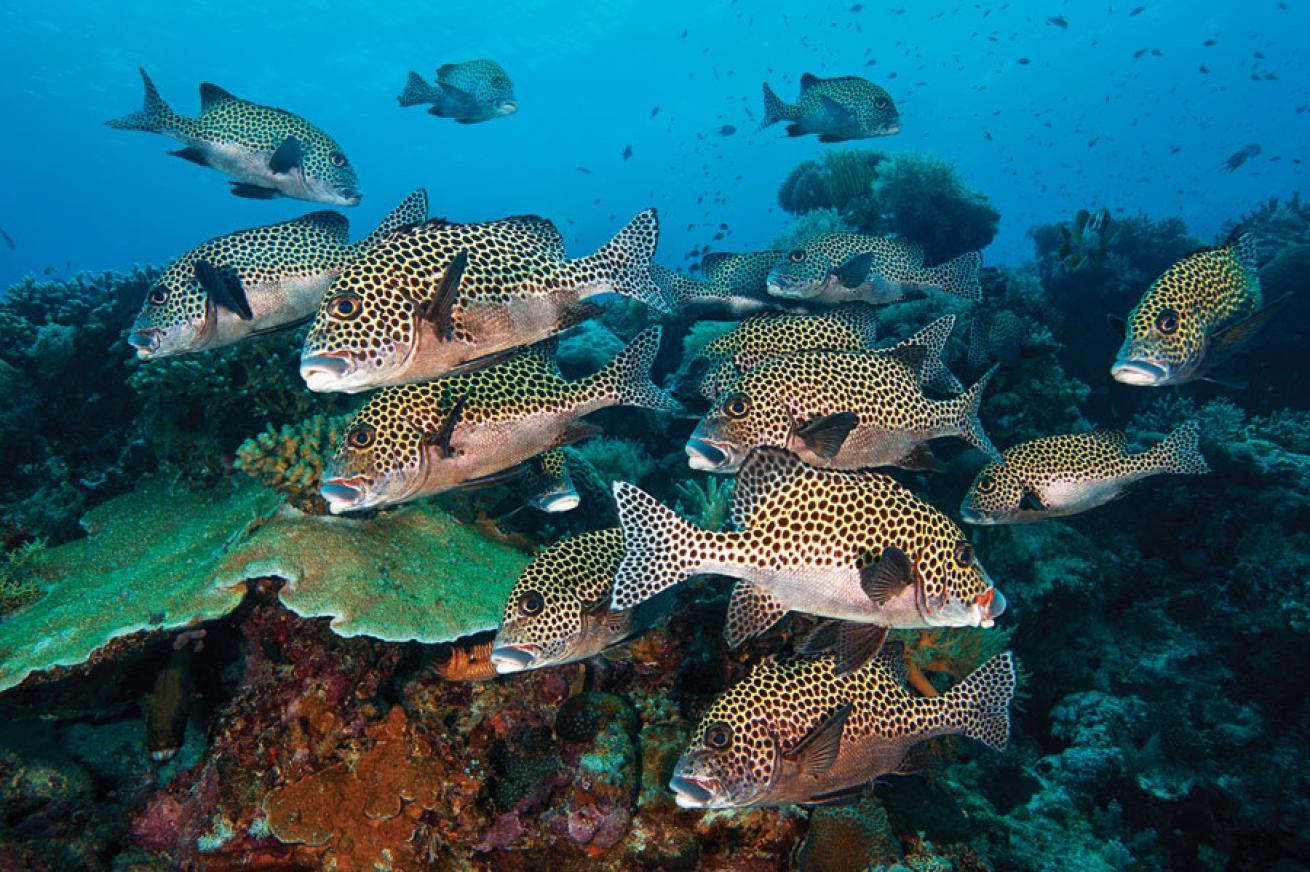
Kevin Palmer and Tanya BurnettSpotted sweetlips congregate underwater at a cleaning station.
Tubbataha Reefs Natural Park is comprised of two huge atolls and one seamount in the middle of the Sulu Sea. It takes roughly 12 hours of open-ocean cruising to reach it — and that’s in good weather. The heavy, solid nature of the yacht makes for a welcome soft passage. Being this remote, the region is accessible only by liveaboard yachts during a short, three-month-long weather window each year.

ShutterstockSoft drinks and beers are free aboard the Philippine Siren. This is just one of the many amenities this luxury liveaboard offers.
The park was established in 1988, making it one of the oldest marine parks in Asia, and this long- standing protection promises prolific marine life and exceptional reefs. Researchers have discovered that this submarine eden is a nursery for a huge portion of the Coral Triangle, including Indonesia, Malaysia and, of course, the Philippines. There are few places on Earth that serve up such density of life, and our anticipation after the overnight cruise is electric.
**Next Page: Tubbataha's Colorful Creatures **
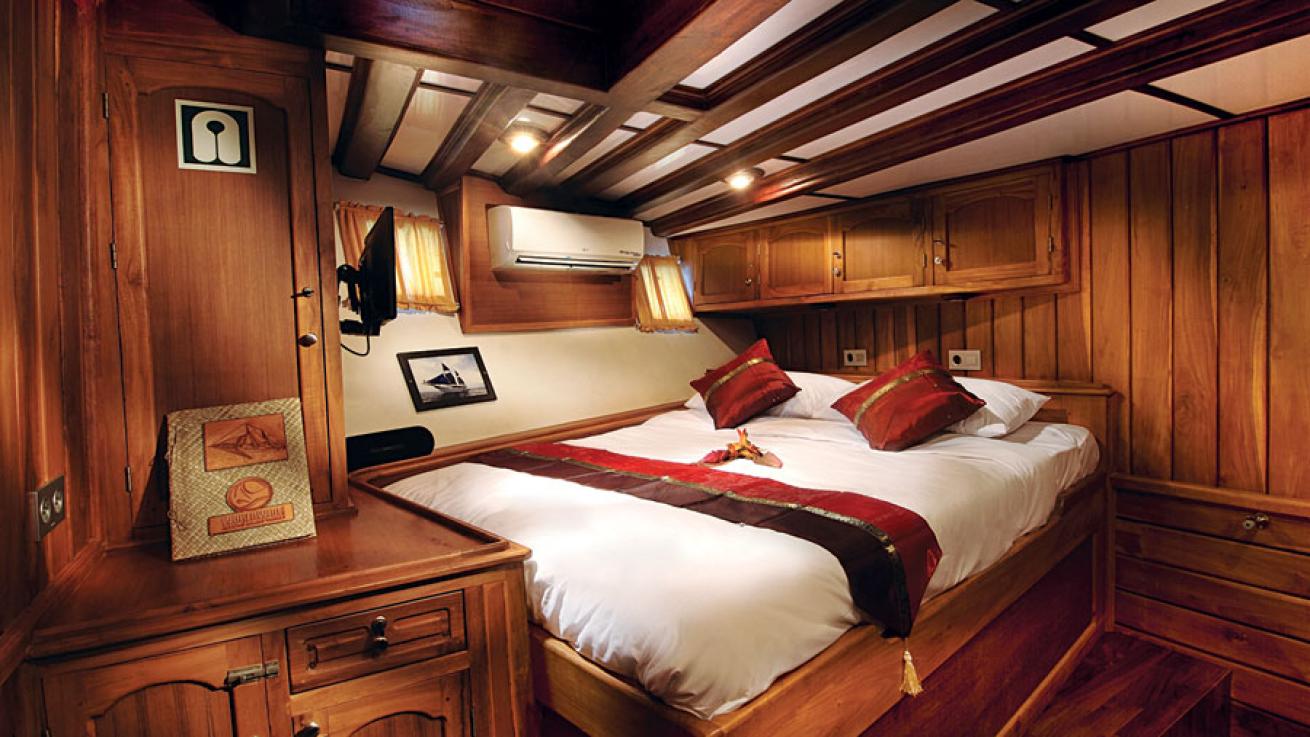
Courtesy Philippine SirenTwin or double cabins come with plenty of room, soft cotton robes, fresh towels and an in-room computer loaded with movies.
Tubbataha is famous for its schooling fish, which show up almost everywhere — and we are not disappointed. We work counterclockwise around the massive atolls, dropping down on a plethora of sites. Some dives have a little bit of everything, and others deliver particular experiences in spades. Schools of bigeye jacks number in the hundreds on several sites, but on a site called the Delsen Wreck, they envelop lucky divers — shifting, turning and charging as one.
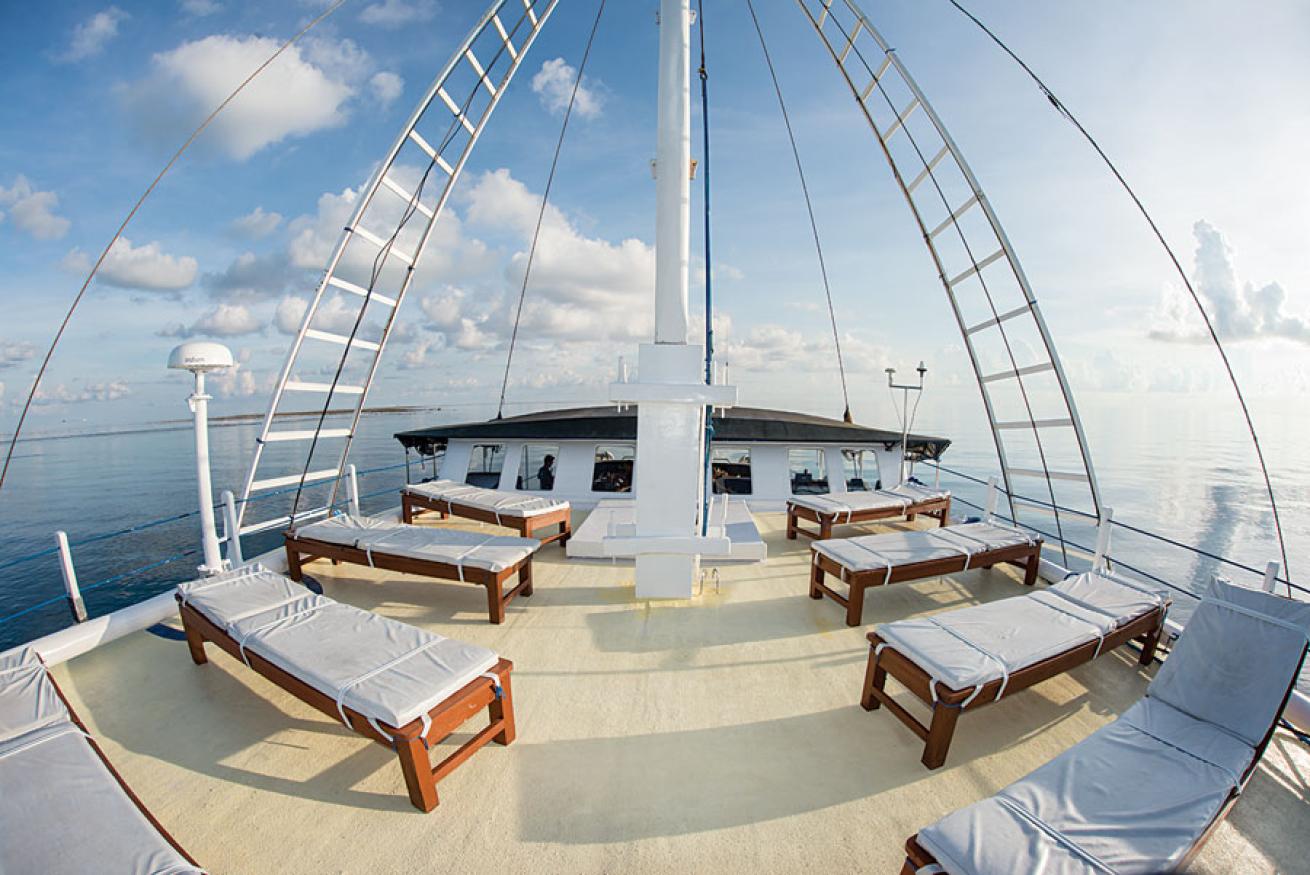
Courtesy Philippine SirenGet a massage, read a book or take a nap during your surface interval. The crew will make this a fabulous trip for you.
After being wowed by the giant school, we turn our focus to smaller, more-colorful schools, such as the diagonal-banded and many-spotted sweetlips that pile up at cleaning stations on the reef top. Mouths open and gills spread for the small wrasse that provide services at these marine spas, the blissed-out clientele are often a more cooperative photo subject.
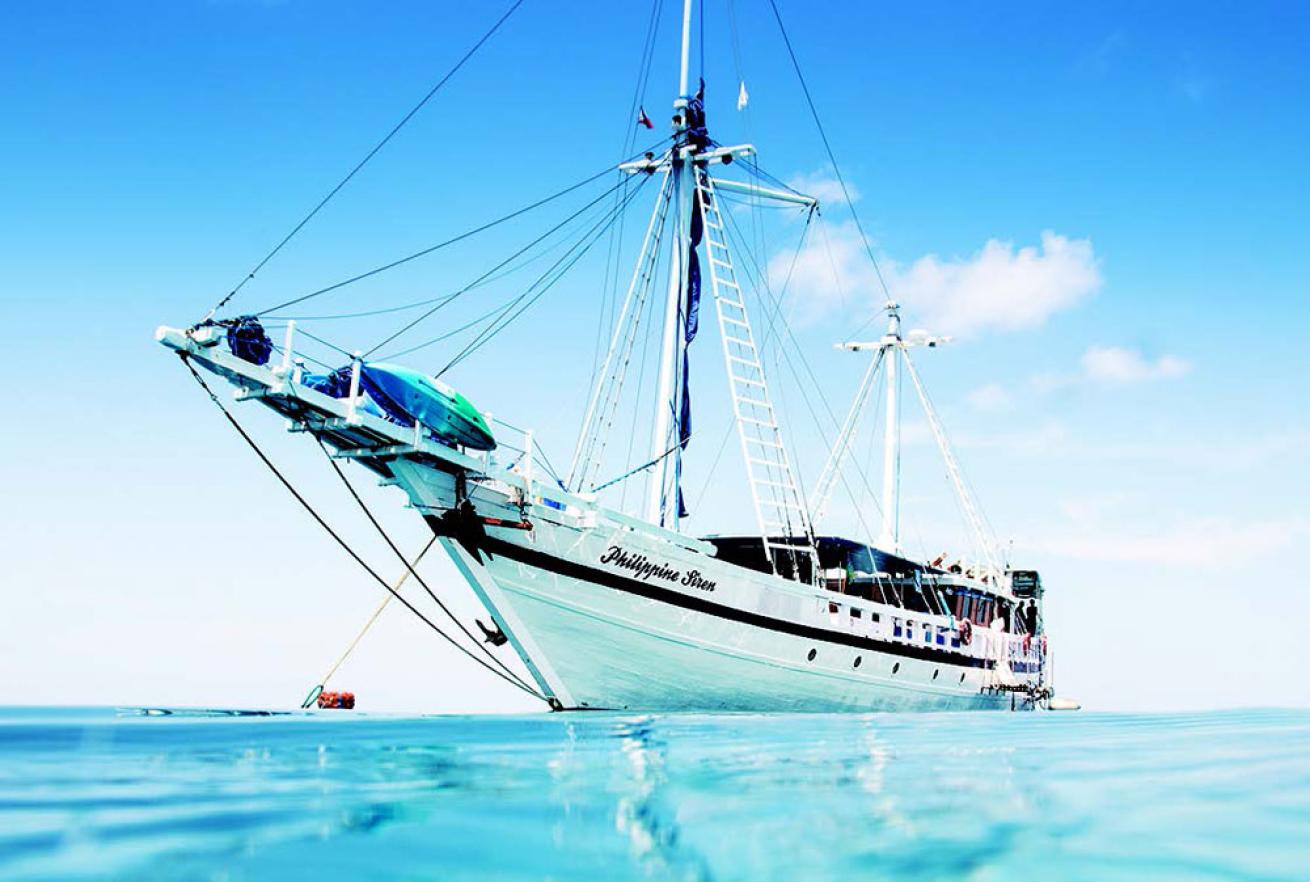
Kevin Palmer and Tanya BurnettThe Philippine Siren liveaboard is a traditional Phinisi vessel crafted from solid wood.
Dive times always expire before we exhaust our photo ops, but returning to our elegant vessel is a definite pleasure. Cold drinks and hot tea are proffered by our friendly steward before we even peel out of our wetsuits, and one of the crew whisks it away for a soapy bath (wetsuits appear atop our tanks in time for the next dive). We are spoiled. Four dives a day is the norm, and with five eat ing sessions planned, there is barely time to sneak in a nap or a delicious massage in the afternoon. (Yes, one can always pass on a dive, but in a place like Tubbataha, not many will opt for this.) As guest Richard Rostant says after surfacing from his first whale-shark encounter ever at the site named Ko Ok, “Anything can happen here, on any dive — every moment counts!”
The one thing that no one ever misses is dinner, when the chef reveals the evening’s many-course menu in elaborate and charming detail. Finally, after describing every last condiment, he issues an invitation: “Feel at home — what are you waiting for?” To which we respond with cheers, clinking silverware, mild mayhem and hearty appetites.
Our amazing weather conditions each morning — placid seas, no wind — defies description. There’s no land in sight, save spits of sand and one chunk of limestone with a lighthouse on the South Atoll, and so finding where water meets sky is nearly futile. Our underwater exploits are accompanied by a riot of color and frenetic activity. Dives on Donato’s Wall — named for our incredible dive guide, whose wit and contagious laughter are legendary — serve up caves and overhangs draped with soft corals and sponges, lined with plush tubastrea coral. Some of our favorite photo subjects are the tight schools of pennant bannerfsh that form stacks beneath the brilliant sea fans — as these fish wait to be cleaned, we are treated to a carnival of color. Big dogtooth tuna and giant trevally jacks prowl on the reef edge, and hawksbill and green sea turtles soar overhead going to and from the reef top. These marine reptiles are seen on virtually every dive, and largely ignore us as they feed and visit cleaning stations. On some sites they appear all over the reef — particularly at dusk, when they might be finding refuge from predators like the local tiger sharks.
On our last day we head for Jessie Beazley Reef, a seamount with a substantial plateau rising from the depths — this outpost is a magnet for pelagics from miles around. The Siren is one of only a handful of boats to visit this distant corner of the park, which is hours from the other atolls. It’s wild even by Tubbataha standards, and delivers unexpected wonders on every visit. Working with the current is key, and when we find the spot where the action is happening on our last dive, we can only sit back and watch the show. It’s as if we’ve crashed the most festive party on the reef. Schools of batfish, jacks, bannerfish, triggers and snapper mingle at random, while butterflyfish and anthias rain down like leaves on a fall day. Hundreds of fish tighten as the current strengthens, parting only for the reef sharks that cut a swath through the schools of fish. It is a scene that casts a spell that can be broken only by our computers’ deco limits.
This is why we make the long journey, why we come back again and again. We board a boat in search of sea treasure — Tubbataha delivers it in abundance.
**Next Page: What to Know Before You Go **
NEED TO KNOW
When to Go: Philippine Siren (sirenfleet.com) spends the year broken into five itineraries based on diving conditions. For Tubbataha, the season is mid-March to mid-June.
Dive Conditions: Diving the Philippines can be very different depending on location. In most, visibility ranges from 50 to 100 feet, and temperatures from 79 to 82 degrees F. Strong currents and cold upwellings can be present in many locations. The Philippines is located in a typhoon belt, so trip insurance is highly recommended for diving any time of year.
Operator: There are eight deluxe cabins — all with private bathrooms — for up to 16 passengers. The Philippine Siren provides three dive guides for its guests, plus an onboard staff of nine. Two tenders handle the divers in three boat runs to the sites.
Price Tag: A six-night charter to Tubbataha with up to four dives per day runs roughly $3,700 per person.
5 REASONS TO DIVE TUBBATAHA ABOARD _PHILIPPINE SIREN _
1. Spacious****** **and****** **comfortable****** **cabins Twin or double cabins come with plenty of room, soft cotton robes, fresh towels, and an in-room computer loaded with movies — as if you’ll have time to watch them.
2. Facilities for underwater photographers and videographers The Siren provides both indoor and outdoor areas desig- nated for charging, means to prepare your camera and video equipment, large rinse tanks on the dive deck, and a well-trained crew.
3. Excellent service Whether it’s ordering a cappuccino, getting a massage on the aft deck, or making sure your laundry is clean, the crew is ready to help.
4. Better than home-style cooking Sumptuous vittles always abound — so much so, you might wish for a larger wetsuit by the end.
5. Free soft drinks, beer and nitrox When you’ve spent a few bucks to get there, it’s nice to have a few perks!










